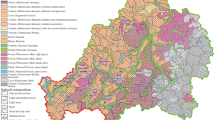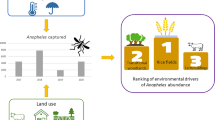Abstract
Tularaemia, a zoonosis of veterinary and public health importance, commonly occurs in the Czech Republic as well as other countries of Northern Hemisphere. The objective of this study was to analyse the environmental conditions of distribution of natural foci of tularaemia and their long-term persistence in the Czech Republic. A geographic information system has been used for this purpose. A new variable (x t), the mean number of natural foci in a specific area, has been suggested for the evaluation of diseases occurring in natural foci. Comparing two 15-year periods, a close correlation between the geographic distribution and numbers of natural foci of tularaemia in the Czech Republic in 1971–1985 and 1986–2000 (r = 0.91, n = 1814, t = 92.50, p = 0.01) was found. Natural foci of tularaemia have been persistent, but not stationary, over the period of 30 years and the geographic area of their occurrence has not been considerably growing or diminishing in the Czech Republic. The highest numbers of natural foci of tularaemia were in habitats of alluvial forests (x t = 7.20), geographic areas of up to 200 m of elevation above sea (x t = 9.18), 8.1–10.0 °C of mean annual air temperature (x t = 6.24), 450–700 mm of mean annual precipitation (x t = 2.84), and 2001–2200 hour of mean annual sunshine duration (x t = 8.77). It was proved that tularaemia persists in specific areas of natural foci, the general environmental conditions of which can be defined and make it possible to predict the occurrence of tularaemia in other areas of suitable conditions.
Similar content being viewed by others
References
Quinn PJ, Carter ME, Markey B, Carter GR. Clinical Veterinary Microbiology. London: Wolfe Publishing, 1994: 259–260.
Guryčová D. First isolation of Francisella tularensis subsp. tularensis in Europe. Eur J Epidemiol 1998; 14(8): 797–802.
Guryčová D, Výrosteková V, Khanakah G, Kociánová E, Staněk G. Importance of surveillance of tularaemia natural foci in the known endemic area of Central Europe, 1991-1997. Wiener Klin Wochenschrift 2001; 113(11-12): 433–438.
Pikula J. Ecological - epizootiological studies into the tularaemia of the European Hare Lepus europaeus Pallas, 1778. VFU Brno 1996, PhD Thesis (In Czech).
Guryčová D, Kopcok M. Surveillance of Francisella tularensis infestation in dogs from Bratislava. Vet Med Czech 1992; 37(3): 169–176.
Guryčová D, Kociánová E, Výrosteková V, Řeháček J. Prevalence of ticks infected with Francisella tularensis in natural foci of tularaemia in Western Slovakia. Eur J Epidemiol 1995; 11(4): 469–474.
Hoflechner-Poltl A, Hofer E, Awad-Masalmeh M, Muller M, Steineck T. Prevalence of tularaemia and brucellosis in European brown hares (Lepus europaeus) and red foxes (Vulpes vulpes) in Austria. Tierärzt Umschau 2000; 55(5): 264–268.
Hubálek Z, Sixl W, Halouzka J. Francisella tularensis in Dermacentor reticulatus ticks from the Czech Republic and Austria. Wiener Klin Wochenschrift 1998; 110(24): 909–910.
Hubálek Z, Treml F, Halouzka J, Juřicová Z, Huňady M, Janík V. Frequent isolation of Francisella tularensis from Dermacentor reticulatus ticks in an enzootic focus of tularaemia. Med Vet Entomol 1996; 10(3): 241–246.
Hubálek Z, Juřicová Z, Svobodová S, Halouzka J. A serologic survey for some bacterial and viral zoonoses in game animals in the Czech Republic. J Wildlife Dis 1993; 29(4): 604–607.
Výrosteková V, Guryčová D, Kociánová E, Řeháček J. Ticks as important epidemiological indicators of natural foci of tularaemia in Slovakia. Biologia 2001; 56(Suppl. 9): 97–103.
Pikula J, Beklová M. Ecological distribution of Phasianus colchicus in Czechoslovakia. Acta Sc Nat Brno 1987; 21(2): 1–47.
Libich J. Tularaemia. (in Czech). Prague: Avicenum, 1981; 30–37.
Štěrba F. Studies into the Brucella infection in the European Hare (Lepus europaeus Pall.) and guinea pig (Cavia aperea Erxl.). VFU Brno 1993, Habilitation Thesis (in Czech).
Author information
Authors and Affiliations
Rights and permissions
About this article
Cite this article
Pikula, J., Treml, F., Beklová, M. et al. Ecological conditions of natural foci of tularaemia in the Czech Republic. Eur J Epidemiol 18, 1091–1095 (2003). https://doi.org/10.1023/A:1026141619810
Issue Date:
DOI: https://doi.org/10.1023/A:1026141619810




